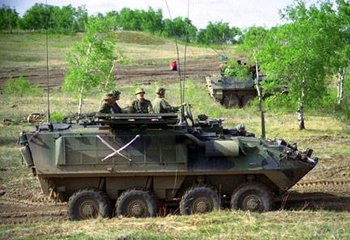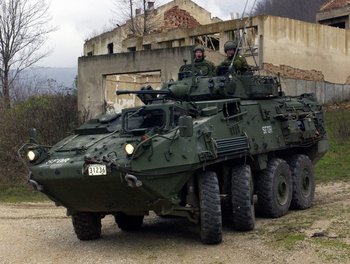|
|
|
|
|
Armoured Personnel Carriers The Armoured Personnel Carrier (APC) was developed during the 20th Century in order to protect infantry on the modern battlefield and assist them in moving forward. A later development, Infantry Fighting Vehicles refined the concept, and allowed infantry to employ their weapons from within the safety of an armoured vehicle. In addition to armour, later APCs and IFVs also allowed soldiers to operate in a radioactive or chemical environment. First World WarAs the tank was developed during the First World War, the necessity for infantry and tanks to work together was made apparent during the first combat use of armoured fighting vehicles. The tank itself, however had been developed to protect soldiers from the proliferation of automatic weapons and indirect firing weapons on the modern battlefield. A possible solution - an armoured carrier for infantry - was briefly considered.
In the summer of 1917, the British had attempted to design an armoured vehicles with the specific requirements of infantry in mind. Two prototypes of the Mark IX were drawn up, but the design was not considered a success and the vehicle did not see action. Second World WarBetween the wars, the various militaries experimented with mechanization and mobile forces; the Americans and Germans both gravitated towards the use of half-tracked vehicles (a standard truck suspension in the front, with tracks in the back) for their motorized infantry. The British standardized Universal Carriers, and Canada also began to use these vehicles in large numbers early in the war. The carrier was not well suited to the role of carrying motorized infantry directly into battle, and Motor battalions in the Commonwealth (i.e. motorized infantry units attached directly to armoured divisions) used a mixture of US-designed halftracks and Universal Carriers for transport. KangaroosIn Normandy, the commander of II Canadian Corps, Lieutenant General G.G. Simonds, ordered the creation of a squadron of armoured personnel carriers using surplus artillery vehicles. A complement of 76 US-produced M7 Priest Self Propelled Guns had their 105mm guns stripped and troop seats installed in their place in order that infantry might be protected from shellfire during Operation TOTALIZE. The vehicle was named for the code name of the workshop doing the conversion: Kangaroo. The experiment proved successful, and later purpose built Kangaroos were made from Ram tanks. The squadron of Kangaroos was expanded to become the 1st Canadian Armoured Personnel Carrier Regiment (renamed in Dec 1944 to 1st Canadian Armoured Carrier Regiment). A similar regiment was also created by the British in North-West Europe.
PostwarM113A1
The vehicle featured a hydraulic ramp for disembarking infantry (the Kangaroo required fully laden infantryman to clamber over the high rounded hull sides) as well as roof hatches where a variety of weapons could be mounted. The TOW Under Armour was one such adaptation used by the Canadian Army. The vehicle was also used for engineering tasks by the addition of a dozer blade or crane. The M548 tracked cargo carrier was another variant used by Canada, as well as the M577 Command Post. The vehicle was upgraded in the 1980s for service in the Balkans by using ACAV (Armoured Cavalry Assault Vehicle) kits originally designed for US M113s in Vietnam in the late 1960s. This conversion included an armoured turret for the commander's .50 calibre machine gun.
In 1979, the US began upgrading the M113A1 to A2 configuration with improvements to the suspension and cooling system. Canadian versions similarly upgraded received the same designation. Upgrades beginning in 1987 created the M113A3 variant, with improvements to engine power and crew survivability. In 2001, 289 of the original 1,143 M113's delivered in the 1960s to early 1990s were upgraded to M113A3s, and the remainder were declared surplus.
Characteristics:
BobcatThe Bobcat was a Canadian prototype vehicle designed in 1958.
Grizzly
The Grizzly featured rifle ports for infantrymen, and a crew of three including driver, gunner and commander. The Cadillac-Gage turret contained both a C6 machine gun and an M2 .50 calibre machine gun.2 In 2000, some Grizzlies were converted to gun tractors for RCHA guns deployed to the former Yugoslavia. At right, a Canadian Grizzly in the colours of Jedinica za Specijalne Operacije
|
|
Characteristics |
Engine Details |
Dimensions |
|
|
|
Notes
- Rawling, Bill. Surviving Trench Warfare: Technology and the Canadian Corps 1914-1918
- Diagram from the DND 101 website.
© canadiansoldiers.com 1999-present










 Canadian M113A2s with ACAV kits in the Balkans. Ed
Storey Photo.
Canadian M113A2s with ACAV kits in the Balkans. Ed
Storey Photo. M113
adapted for signals work, 1989. DND Photo.
M113
adapted for signals work, 1989. DND Photo.

 None of the AVGPs were
given a numerical designation, though the Grizzly did acquire several
official names, including APC, Wheeled Armoured Personnel Carrier
(WAPC), and Infantry Section Carrier (ISC), as well as the original name
"Car, Armoured, Personnel Carrier."
None of the AVGPs were
given a numerical designation, though the Grizzly did acquire several
official names, including APC, Wheeled Armoured Personnel Carrier
(WAPC), and Infantry Section Carrier (ISC), as well as the original name
"Car, Armoured, Personnel Carrier." 

 Bison
Bison

